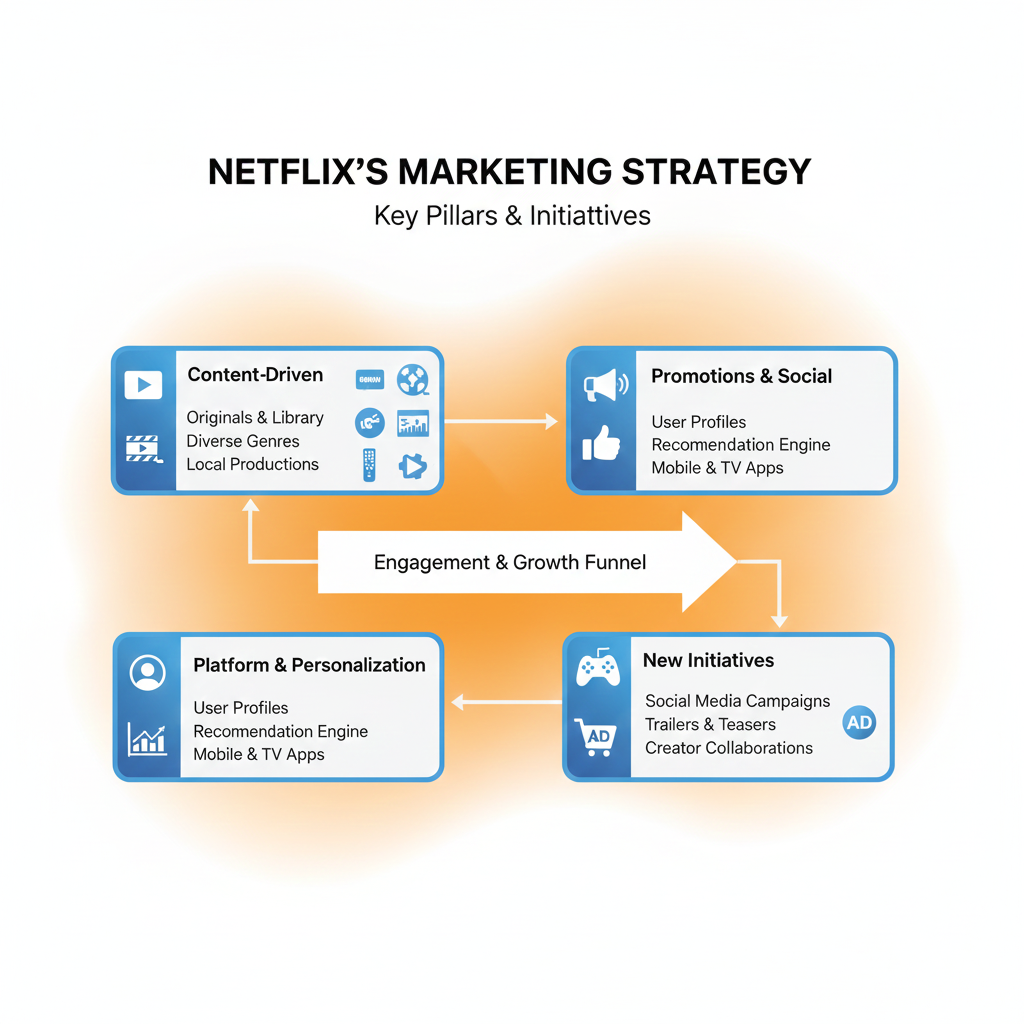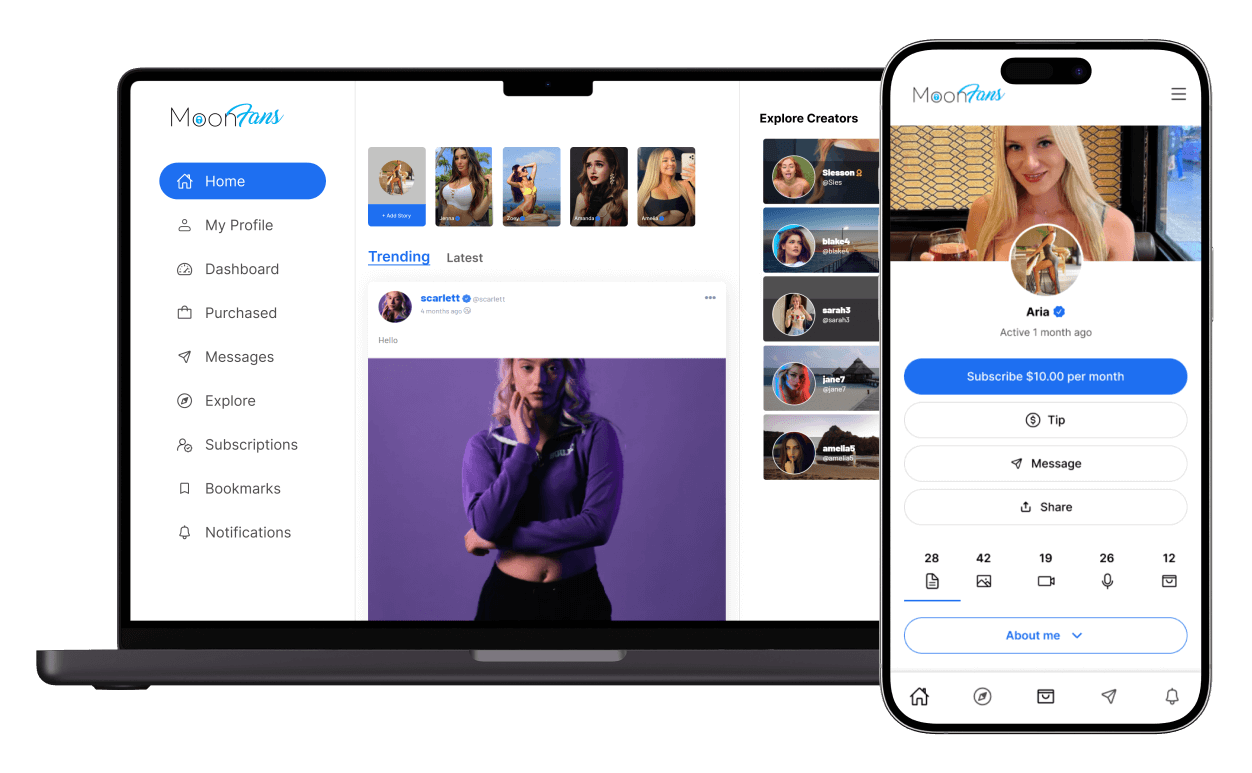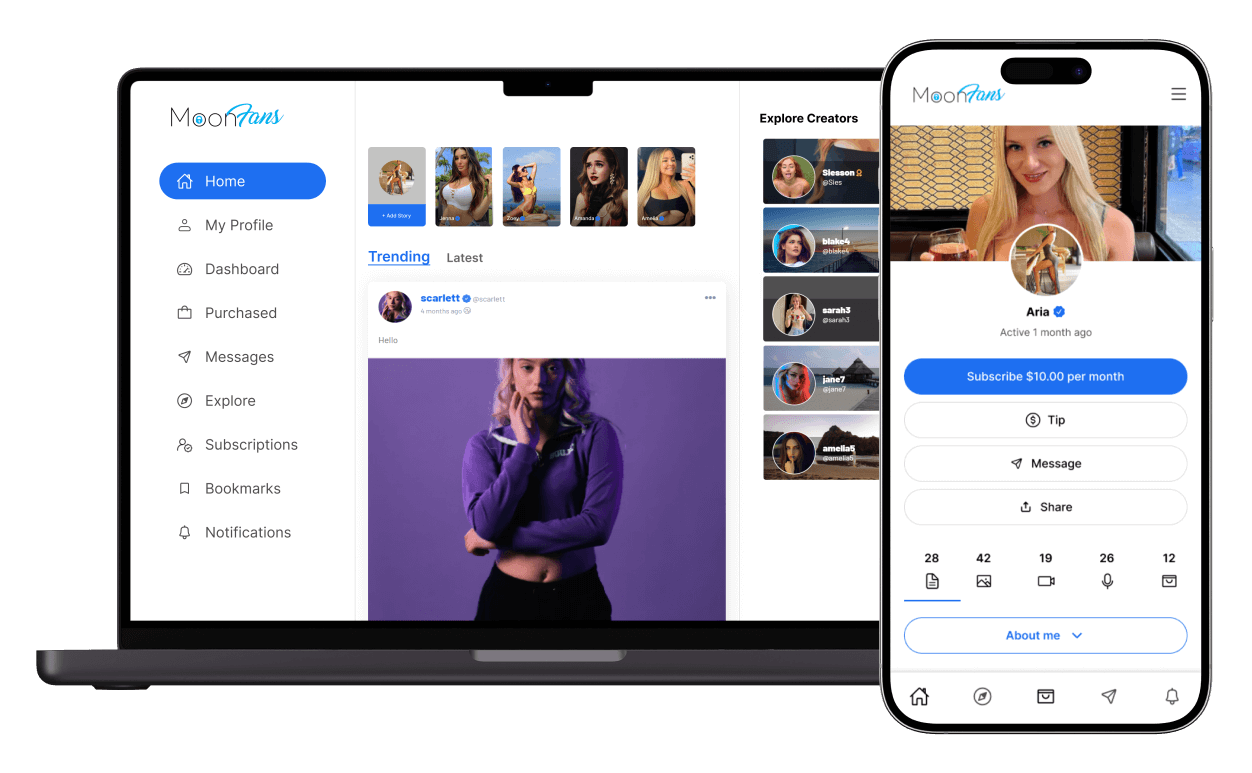Netflix operates in a complex, fast-changing external environment, shaped by regulations, #technology , #market economics, consumer behaviour, and global challenges.
A #PESTLE #analysis helps us understand the macro-environmental factors that affect Netflix’s strategic decisions, risks, and long-term growth.
https://pratsdigital.in/ne...
The reason?
A sharp, evolving, and highly data-driven #marketing #strategy .
In this #article , I’ll break down Netflix’s current marketing strategy (2025) with a approach covering everything from #content strategy to #technology , partnerships, social media, and #growth tactics.
https://pratsdigital.in/ne...

Netflix’s Current Marketing Strategy (2025): A Complete Breakdown - PratsDigital
Netflix’s current marketing strategy explained: data-driven personalization, global content, ad-tier expansion, partnerships, and social media innovations.
https://pratsdigital.in/netflix-current-marketing-strategy/I’ve been #writing about #business models and #marketing strategies of top #tech platforms for a long time, and Netflix is one of the most fascinating #brands . Their story is all about reinvention — DVDs → streaming → originals → gaming → AI-driven entertainment.
So in this #article , I’m breaking down Netflix’s full SWOT analysis so you can understand how the company survives, grows, and competes in an industry that changes every month.
https://pratsdigital.in/ne...
Want to create a full-featured live-shopping app where sellers can stream and sell products in real time? OyeLabs’ Whatnot Clone is a white-label, fully customizable solution (Web + iOS + Android) that comes with full source-code ownership. It offers low-latency streaming, live bidding or auctions, inventory management, seller wallets, real-time notifications, and a robust admin dashboard — perfect for building a modern live-commerce marketplace.
🔗 https://oyelabs.com/whatno...
#LiveCommerce #ecommerce #MarketplaceStartup #WhiteLabelApp #LiveShopping
Want to build a real-time, live-commerce app where creators can stream and sell products like on Whatnot? OyeLabs’ Whatnot Clone offers a scalable, white-label solution with full source code ownership. You get Web, iOS & Android support, low-latency streaming, real-time bidding, inventory sync, seller wallets, and admin analytics — with deployment in just 10 days.
https://oyelabs.com/whatno...
#LiveCommerce #ecommerce #startup #WhiteLabelApp #StreamingStore

Whatnot Clone - Start Live Shopping Platform in 10 Days
Whatnot clone to build your own live commerce platform with real-time streaming, 100% customizable modules, quick launch setup, and 2 months free support.
https://oyelabs.com/whatnot-clone/Want to build a real-time, live-commerce app where creators can stream and sell products like on Whatnot? OyeLabs’ Whatnot Clone offers a scalable, white-label solution with full source code ownership. You get Web, iOS & Android support, low-latency streaming, real-time bidding, inventory sync, seller wallets, and admin analytics — with deployment in just 10 days.
https://oyelabs.com/whatno...
#LiveCommerce #ecommerce #startup #WhiteLabelApp #StreamingStore
Build a powerful subscription-based content marketplace with Oyelabs’ fully-customizable, white-label OnlyFans clone. Give creators the tools they need—subscriptions, pay-per-view, tips, live streaming, merchandise sales—alongside advanced admin controls, secure payments, and censor-free deployment. Perfect for entrepreneurs ready to tap into the booming creator economy.
🔗 https://oyelabs.com/onlyfa...
#onlyfansclone #CreatorEconomy #SubscriptionApp #MonetizeContent #WhiteLabelSolution

OnlyFans Clone | Launch OnlyFans-Style Creator Marketplace
Launch your creator-friendly content subscription platform with our OnlyFans clone script. Modern UI, 100% customizable script loaded with latest features.
https://oyelabs.com/onlyfans-clone/Build a powerful subscription-based content marketplace with Oyelabs’ fully-customizable, white-label OnlyFans clone. Give creators the tools they need—subscriptions, pay-per-view, tips, live streaming, merchandise sales—alongside advanced admin controls, secure payments, and censor-free deployment. Perfect for entrepreneurs ready to tap into the booming creator economy.
🔗 https://oyelabs.com/onlyfa...
#onlyfansclone #CreatorEconomy #SubscriptionApp #MonetizeContent #WhiteLabelSolution

OnlyFans Clone | Launch OnlyFans-Style Creator Marketplace
Launch your creator-friendly content subscription platform with our OnlyFans clone script. Modern UI, 100% customizable script loaded with latest features.
https://oyelabs.com/onlyfans-clone/Build a powerful subscription-based content marketplace with Oyelabs’ fully-customizable, white-label OnlyFans clone. Give creators the tools they need—subscriptions, pay-per-view, tips, live streaming, merchandise sales—alongside advanced admin controls, secure payments, and censor-free deployment. Perfect for entrepreneurs ready to tap into the booming creator economy.
🔗 https://oyelabs.com/onlyfa...
#onlyfansclone #CreatorEconomy #SubscriptionApp #MonetizeContent #WhiteLabelSolution

OnlyFans Clone | Launch OnlyFans-Style Creator Marketplace
Launch your creator-friendly content subscription platform with our OnlyFans clone script. Modern UI, 100% customizable script loaded with latest features.
https://oyelabs.com/onlyfans-clone/Build a powerful subscription-based content marketplace with Oyelabs’ fully-customizable, white-label OnlyFans clone. Give creators the tools they need—subscriptions, pay-per-view, tips, live streaming, merchandise sales—alongside advanced admin controls, secure payments, and censor-free deployment. Perfect for entrepreneurs ready to tap into the booming creator economy.
🔗 https://oyelabs.com/onlyfa...
#onlyfansclone #CreatorEconomy #SubscriptionApp #MonetizeContent #WhiteLabelSolution
#tiktokclone #tiktokclonescript #AppLikeTikTok #clonescript
#business #AppDevelopment #ShortVideoApp
https://oyelabs.com/tiktok...

TikTok Clone - Launch Your Own TikTok Like App 2025
TikTok Clone - A 100% customizable, feature-rich solution. Launch video dubbing & video-sharing platform like TikTok, Dubsmash, Musical.ly.
https://oyelabs.com/tiktok-clone/Perfect for entrepreneurs! Launch a trending video sharing business with a feature-rich Vimeo clone script. Includes monetization, live streaming, and full admin control to scale fast and succeed in the digital market.
For Free Demo: https://www.trioangle.com/...
Whatsapp - +91 63796 30152
Email ID - salestrioangle.com
Telegram - https://t.me/Trioangle_Tec...
#vimeoclone #vimeoclonescript #business #videostreamingscript #startupbusiness #startupsolution #sucessbusiness #tiktokclone
Zaher Birawi, who was described in Parliament as a person with links to Hamas, called himself a “founding member” of the Freedom Flotilla International Coalition, which arranged the voyage by the aid boat Madleen.
Israeli forces boarded and seized the boat on Sunday, detaining the 12 pro-Palestinian activists it was carrying, including Ms Thunberg, as it attempted to bring a “symbolic” amount of aid to Gaza in defiance of an Israeli naval blockade.
Mr Birawi, a Palestinian-British journalist at an Arabic-language satellite TV channel in London, was at the launch of the Madleen a week ago, livestreaming it from its dock in Sicily. Ms Thunberg gave a speech before the boat set sail for Gaza.
In 2013, Mr Birawi was named by Israel as a Hamas operative in Europe, and is the head of the Europal Forum, which Israel designated as a terrorist organisation in 2021.
The Europal Forum has strongly denied any terror links, and in 2021 Mr Birwani received compensation after taking legal action against a financial database he said had wrongly placed him on a terrorism watch list.
He denied ever being involved in any illegal acts within the scope of terrorism crimes.
Speaking in the Commons in October 2023, Christian Wakeford, the Labour MP for Bury South, used parliamentary privilege to name 63-year-old Mr Birawi as a Hamas operative living in Barnet, north London.
“He is listed as a trustee of a UK-registered charity, Education Aid for Palestinians, and publicly available video shows him hosting a 2019 event in London titled Understanding Hamas,” Mr Wakeford told MPs.
“I’d seen videos of people streaming across the border on Twitter, now X, and I’m like, ‘Are these? Is this real?’” Musk said, referring to the decontextualized and unverifiable clickbait that dominates the social media platform he now owns.
“So I said, I’m going to the border myself. So I went to Eagle Pass, Texas and, sure enough, people streaming across the border,” Musk claimed.
The Biden administration is actively aiding and abetting illegal immigration, because they are viewed as future voters
— Elon Musk (elonmusk)
The clips prompted the world’s richest man to embark on his takeover of Twitter, he said, arguing that the purchase was motivated by a desire to strip the platform of “censorship” and “let the marketplace of idea
Kickstart your online education business with our Udemy clone script at 50% OFF – exclusively for startups! Create your own eLearning platform with powerful features like course creation, video streaming, secure payments, and instructor dashboards. Perfect for entrepreneurs aiming to enter the booming edtech market. Don’t miss your chance to build the next big learning platform at half the cost!
To Know More: https://www.trioangle.com/...
WhatsApp: +91 6379630152
Mail: salestrioangle.com
Telegram: https://t.me/Trioangle_Tec...
#udemyclone #education #elearning #udemycloneapp
The incident reportedly occurred after Johnny Somali, caused outrage by desecrating a monument dedicated to the victims of Japan’s wartime sexual slavery during World War II. The streamer, infamous for his inflammatory behavior across Asia, was live-streaming near the monument when Yu confronted him. Witnesses, Yu punched Somali after an escalating verbal exchange.
Yu was arrested immediately after the incident and is now under investigation on charges of assault.
Yu showed no remorse, saying he had acted to defend South Korea’s honor. “I could not stand by while someone insulted the victims of history and our nation,” he said.
How has increased interconnectedness influenced religious practices and beliefs?
By Hugo Keji
Increased interconnectedness, a hallmark of globalization, has significantly influenced religious practices and beliefs in several ways.
This interconnectedness, driven by advancements in communication, transportation, and technology, has facilitated the exchange of ideas and practices across religious boundaries, leading to both transformation and innovation within religious traditions.
Here are some key ways this has manifested:
1. Diversification and Syncretism
Blending of Religious Traditions: Increased contact between different religious groups has led to the blending of practices and beliefs, a phenomenon known as syncretism. For example, some religious ceremonies might incorporate elements from multiple faiths, reflecting the multicultural environments in which they are practiced.
Personalized Spirituality: Individuals now have access to a wide array of religious ideas and practices, allowing them to create more personalized forms of spirituality. People might adopt meditation techniques from Buddhism, ethical principles from Christianity, and rituals from indigenous traditions, crafting a unique spiritual path that resonates with their personal experiences and worldview.
2. Adaptation to Modern Contexts
Reinterpretation of Doctrines: Religious doctrines and teachings have been reinterpreted in light of contemporary issues and global challenges. For instance, many religious leaders and communities have reexamined their stances on topics like environmental stewardship, gender equality, and human rights, aligning their beliefs with global ethical standards.
Integration of Technology: Religious practices have increasingly incorporated technology, such as online worship services, virtual religious communities, and digital religious texts. This adaptation has made religious practices more accessible, especially for those who may not be able to participate in traditional, in-person gatherings.
3. Strengthening of Religious Identity
Revival Movements: In response to the global spread of secularism and religious pluralism, some religious groups have experienced a revival, emphasizing a return to core beliefs and practices. This can be seen in the growth of movements that stress traditional religious values and resist external influences.
Global Religious Communities: The formation of global religious networks has allowed believers to maintain and even strengthen their religious identity despite being geographically dispersed. Social media, online forums, and streaming services have enabled people to participate in religious communities that transcend national and cultural boundaries.
4. Interfaith Dialogue and Cooperation
Increased Interfaith Engagement: The interconnectedness of the modern world has fostered greater interfaith dialogue and cooperation. Religious groups often collaborate on social justice issues, humanitarian aid, and peace-building efforts. These interactions have led to a greater understanding and respect for diverse religious traditions.
Shared Ethical Concerns: Many religions have found common ground on global issues such as poverty, environmental sustainability, and human rights. This shared focus has led to joint initiatives that transcend religious differences, fostering a sense of global responsibility and ethical commitment.
5. Challenges to Traditional Practices
Cultural Dilution: The widespread dissemination of global culture can sometimes dilute traditional religious practices, especially when they are commercialized or secularized. For example, religious festivals might lose some of their spiritual significance as they become popularized in broader cultural contexts.
Pressure to Modernize: Traditional religious practices that are seen as outdated or incompatible with modern values may face pressure to change. This can lead to tensions within religious communities as they balance the preservation of tradition with the need to remain relevant in a rapidly changing world.
6. Influence of Global Migration
Migration and Religious Diasporas: The movement of people across borders has led to the establishment of religious diasporas, where migrant communities maintain their religious practices in new cultural contexts. These communities often adapt their practices to fit their new environment, blending their traditions with local customs.
Cross-Cultural Religious Influence: Migrants and travelers bring their religious beliefs and practices to new regions, influencing local religious landscapes. This can lead to the introduction of new religious ideas, the revitalization of existing practices, or the creation of entirely new religious expressions.
Increased interconnectedness has deeply influenced religious practices and beliefs, leading to both innovation and adaptation within religious traditions.
While this has enriched religious life by fostering diversity and dialogue, it has also posed challenges to the preservation of traditional practices.
The dynamic interplay between global influences and local religious identities continues to shape the evolving landscape of world religions.
App link: FREE for download... https://www.amazon.com/dp/...
By Hugo Keji
Absolutely, technology has indeed made incredible strides, and smartphones are a prime example of this advancement.
They have evolved from simple communication devices into powerful multi-functional tools that can perform a wide range of tasks.
Smartphones can:-
1. Make and receive calls and texts.
2. Access the internet for browsing, emailing, and social media.
3. Run a variety of applications for productivity, entertainment, education, and more.
4. Take high-quality photos and videos.
Provide GPS navigation.
5. Offer health monitoring features like heart rate tracking.
6. Enable contactless payments.
7. Control smart home devices.
This convergence of functionalities into a single, portable device has transformed how we interact with the world and manage our daily lives.
Here are some more detailed ways in which smartphones have integrated multiple technologies and functionalities:
Communication:-
Calls and Texts: Basic phone functions have expanded to include video calls and multimedia messaging.
Email: Full email functionality, including attachments and syncing across devices.
Instant Messaging: Apps like WhatsApp, Telegram, and Signal offer encrypted messaging and multimedia sharing.
Internet Access:-
Browsing: Full web browsing capabilities, often with ad-blocking and data-saving features.
Social Media: Dedicated apps for platforms like Facebook, Twitter, Instagram, TikTok, Afriprime, Corkroo and healthdata101.
Streaming: High-definition video streaming from services like Netflix, YouTube, and Disney+.
Applications (Apps):-
Productivity: Tools like word processors, spreadsheets, presentation software, and project management apps (e.g., Microsoft Office, Google Workspace).
Entertainment: Games, music streaming (Spotify, Apple Music), and e-book readers (Kindle).
Education: E-learning platforms, language learning apps (Duolingo), and educational games.
Health and Fitness: Fitness tracking, diet and nutrition apps, meditation guides, and telemedicine services.
Photography and Videography:-
Cameras: High-resolution cameras with features like optical zoom, night mode, and portrait effects.
Editing: Built-in photo and video editing tools, as well as professional-grade apps like Adobe Lightroom and Premiere Rush.
Sharing: Instant sharing to social media or cloud storage services.
Navigation and Travel:-
GPS: Real-time navigation with traffic updates, route planning, and public transit information (e.g., Google Maps, Waze).
Travel Apps: Booking flights, hotels, and rental cars (e.g., Expedia, Airbnb), and ride-sharing services (Uber, Lyft).
Finance:-
Banking: Mobile banking apps allow for managing accounts, transferring money, and paying bills.
Payments: Contactless payments using NFC (e.g., Apple Pay, Google Pay) and QR code scanning.
Investments: Trading stocks, managing portfolios, and tracking cryptocurrencies (e.g., Robinhood, Coinbase).
Smart Home Integration:-
Control: Manage smart home devices like lights, thermostats, security cameras, and appliances through apps (e.g., Google Home, Amazon Alexa).
Automation: Set routines and automate tasks based on triggers like location or time of day.
Health Monitoring:-
Sensors: Track physical activity, heart rate, sleep patterns, and more.
Integration: Sync data with wearable devices like smartwatches (Apple Watch, Fitbit) and health apps (Apple Health, Google Fit).
Security:-
Biometric Authentication: Use of fingerprint sensors, facial recognition, and iris scanning for secure access.
Encryption: Secure communications and data storage.
Remote Management: Find and lock lost devices, and wipe data remotely.
Augmented Reality (AR) and Virtual Reality (VR):-
AR Apps: Enhance the real world with digital overlays for gaming, navigation, and education (e.g., Pokémon GO, IKEA Place).
VR Experiences: Immersive experiences for gaming, training, and virtual tours using VR headsets (e.g., Oculus, Google Cardboard).
The convergence of these technologies into a single device has not only simplified many aspects of daily life but also opened up new possibilities for communication, entertainment, productivity, and beyond.
SHARE YOUR COMMENTS AND QUESTIONS........
++++++++++++++++++++++++++++++++++++++++++++++
Health Data 101 by SapperTek INC registered in Taiwan.
With servers in Asia, Europe and America.
Hospitals, Private Clinics, Federal, State and Local Government health departs gets an online storage of all it's data secured 24/7/365
For ONLY USD$3 ... Your patients will appreciate it. Hospitals don't need paper work/cards again.
BE A PARTNER IN YOUR COUNTRY.
Contact for details: Email: sappertekincgmail.com
Absolutely risk free and FREE for download...
App link: https://www.amazon.com/gp/...
https://healthdata101.com
Israeli Prime Minister Benjamin Netanyahu said Saturday that the conditions for ending the country’s war in Gaza “have not changed,” raising questions over a peace proposal laid out by US President Joe Biden which he said Israel submitted.
During a speech Friday, Biden said Hamas had been degraded to a point where it can no longer carry out the type of attack seen on October 7 that launched the current war. Part of the agreement, he said, would see a truce and hostage exchange while Israel and Hamas negotiate a permanent end to the fighting.
It was perhaps the furthest Biden has gone in telling Israel its stated goals for its operation in Gaza have been met, and that the time has arrived to stop the fighting.
The proposal has been welcomed across the international community. The UN, the UK, France, Saudi Arabia and the UAE have all expressed support for Biden’s proposal, while Qatar and Egypt joined the US in calling on Israel and Hamas to “finalize” the proposed ceasefire agreement.
For its part, Hamas said it viewed the plan “positively” and is ready “to deal positively and constructively with any proposal based on a permanent ceasefire.”
But a statement from the Israeli Prime Minister’s Office on Saturday said Israel’s goals — “the destruction of Hamas military and governing capabilities, the freeing of all hostages and ensuring that Gaza no longer poses a threat to Israel” — would need to be met before a permanent ceasefire can begin.
“Under the proposal, Israel will continue to insist these conditions are met before a permanent ceasefire is put in place. The notion that Israel will agree to a permanent ceasefire before these conditions are fulfilled is a non-starter,” the statement said.
Saturday’s statement largely reiterated earlier comments from the Israeli Prime Minister’s Office (PMO) made less than an hour after Biden detailed the peace proposal on Friday, with Netanyahu insisting the country would not end the war until Hamas is defeated and all hostages had been returned.
For all the messaging, however, it is unclear exactly to what degree Israel supports the plan. The earlier PMO statement insisted the “exact outline” of the proposal allows Israel to “maintain” its goals in the conflict.
The Israeli online newspaper The Times of Israel said that Netanyahu’s statement on Saturday was geared towards outlining what kind of ceasefire agreement Israel is prepared to agree to, rather than ruling one out.
Domestic pressure mounts for Netanyahu
Netanyahu is facing domestic pressure, both from opposition leaders to get a ceasefire agreement on the table, and from ministers within his own party not to back down on Israel’s original war goals. Families of Israelis being held hostage are meanwhile urging him to accept the proposal.
Protesters took to the streets of several cities across Israel on Saturday, demanding Netanyahu’s resignation and for early elections to be held.
They also demanded the release of all hostages held in Gaza and for the Israeli government to accept the latest proposal laid out by Biden.
Families of hostages held in Gaza took part in protests in Tel Aviv, Caesaria, Haifa, Herzeliya, Kfar Saba.
At Hostage Square in Tel Aviv, protesters called the names of the 125 hostages still in Hamas captivity.
“Start streaming this deal, so that it will start moving… Start working, start acting,” a woman in Tel Aviv shouted over a loudspeaker.
In Caesarea, protesters called for Netanyahu to accept the hostage release deal that Biden presented.
“There is no victory until every last hostage is returned,” people chanted.
Israeli opposition leader Yair Lapid wrote on X Saturday that Israel’s government “cannot ignore President Biden’s significant speech.”
Lapid said he was offering Netanyahu a “safety net,” saying he would support him in securing a hostage deal if far-right ministers Itamar Ben Gvir and Bezalel Smotrich left the government.
Gvir, Israel’s National Security Minister, had previously threatened to leave Netanyahu’s coalition if a ceasefire is reached before Israel achieves its declared war aims.
Also in his speech on Saturday, Biden alluded to the tensions in the Israeli government, making a direct appeal to ordinary Israelis to voice their support for a hostage agreement that would result in a ceasefire.
“I know there are those in Israel who will not agree with this plan and will call for the war to continue indefinitely. Some, some are even in the government coalition,” he said.
The international pressure Netanyahu’s government is facing to end the war in Gaza has also been mounting, as the conflict approaches its ninth month.
The war was triggered by Hamas attacks on Israeli civilians on October 7, which left around 1,200 people dead and saw more than 200 people taken hostage. The Israeli campaign in Gaza since then has killed more than 36,000 people.
Fighting continues. This week, the Israeli military confirmed that it was operating in the centre of Rafah, southern Gaza, while a top Israeli security official warned the conflict could last into next year.
What's in Israel's three-phase Gaza ceasefire roadmap.....
US President Joe Biden unveiled a three-phase Israeli proposal to end the war in Gaza on Friday, which includes a ceasefire and the release of hostages held by Hamas.
Here are the key elements of the "comprehensive" plan that the 81-year-old called a "roadmap to an enduring ceasefire."
- Phase One -
Biden said the first phase includes a "full and complete ceasefire" lasting six weeks, with Israeli forces withdrawing from "all populated areas of Gaza."
Hamas would release "a number" of hostages captured in the October 7 attacks on Israel, including women, the elderly and the wounded. The remains of some hostages who had been killed would also be returned.
US hostages held by Hamas would also be freed, Biden said, adding that "we want them home."
Hundreds of Palestinian prisoners would be released in exchange.
Palestinian civilians would be allowed to return to their "homes and neighborhoods" throughout Gaza, including in the north, which has been devastated by months of Israeli bombing.
Humanitarian aid would "surge" to 600 trucks a day entering Gaza, while the international community would deliver hundreds of thousands of temporary shelters and housing units.
During the initial six-week period, Israel and Hamas would "negotiate the necessary arrangements to get to phase two, which is a permanent end to hostilities."
The ceasefire would also be extended if the negotiations continue, with mediators the United States, Egypt and Qatar working to ensure they continue, Biden said.
- Phase Two -
Israeli forces would completely withdraw from Gaza under the second phase of the plan, lasting around another six weeks.
Hamas would release "all remaining living hostages" including male Israeli soldiers. This has been a key sticking point for Hamas in the past.
If both sides keep to the deal it will lead to the "cessation of hostilities permanently," Biden quoted the Israeli proposal as saying.
- Phase Three -
A major reconstruction and stabilization plan for Gaza would begin, backed by the US and the international community.
Homes, schools and hospitals would be rebuilt, Biden said. He would also work with regional partners to ensure it happens in a way that "does not allow Hamas to re-arm."
The reconstruction phase would take between three and five years, a senior US official said.
The final remains of any hostages who had been killed would be returned in the third phase.
- What if it goes wrong? -
Biden said that if Hamas "fails to fulfill its commitments under the deal, Israel can resume military operations."
But he added that Egypt and Qatar would work to make Hamas stick to the terms, while the United States would do the same for Israel.
Creatures of Habit Are Happy.
Routines can promote well-being and meaning.
KEY POINTS-
Routines are a common part of our day-to-day living and can enhance well-being.
Researchers have found that everyday routines can build resilience and offer a way to cope with stressors.
Routines can foster well-being under adverse situations or prolonged stress.
Meaning in life is generally considered as derived from the big ticket items of making a difference in one’s life and of having a purpose larger than oneself that makes one’s life have significance. However, on a daily basis, most of us do not live our lives in grand gestures, but in routines. In fact, routines are the fabric of our life. Routines are a common part of our day-to-day living. They make life predictable and offer simple pleasures, such as drinking your morning coffee and streaming the news on your smartphone. But can these daily routines be linked to meaning in life?
Routines and Ruts
Routines may also risk falling into a rut. Routines and becoming routinized are different. Routines may be driven to achieve a goal; for example, mid-19th century British novelist Anthony Trollope rose early and had a schedule of writing a set number of words each morning prior to going to work as a postmaster. However, when routines become rigid and fixed, they are firmly established and can become ruts. For example, someone whose schedule is unvarying, such as rising early every day, working out at a precise time, eating the same food at a fixed time, and who has no room for a change in their schedule is in a rut. That type of routinized living can risk a very narrow experience of life. Moreover, some research suggests that when routines are “set in stone” it can lead to cognitive rigidity which is an obstacle to creativity. For example, doing things the same way all the time or thinking about problems in the same way can be obstacles to creative and flexible thinking. This type of routinized life, while decreasing anxiety in that life is lived in a predictable manner, can also become shallow, automatic, and impede insight (Tournier et al., 2012). On the side against routines fostering well-being are the risks associated with being too habitual in one’s thinking and behavior.
Researchers Ersche and colleagues (2017) developed a “Creature of Habit Scale” and differentiated between habits as routine behavior and automatic responses. In their scale, items such as “I tend to like routine” and always "trying to get the same seat on the bus...or in church; or parking their car or bike in the same place" (p. 80), characterized routine behavior. Automatic responses were defined as behaviors “running on autopilot” particularly focused on mindless eating. That type of automatic behavior may be related to exposure to stress and a coping mechanism. Ersche et al. hypothesized that there may be unique neural substrates at play in these two types of habits. It is possible that neural pathways “ruts” may develop in response to repetitive behavior patterns. On the psychological side, those whose habits are fixed in their acts may be vulnerable to compulsive behavior.
Routines and Meaning
Can a preference for routines risk loss of meaning in life and falling into the routinization rut? Heintzelman and King (2019) examined how routines in thinking and behavior were associated with meaning in life. They sampled men and women from Amazon Mechanical Turk workers (described as a crowdsourcing website for businesses to remotely hire workers). The workers ranged in age from 18 to 72 and were primarily classified as White/European American, 76%, 7% were Black/African American, and 6% Latinx American.
The workers were presented with questions to assess the trait of routinization. Among the questions asked was if one strongly disagreed or agreed as to whether they did things pretty much the same each day and found that a well-ordered life with regular hours as their preference. The researchers also measured the dislike of disruption to workers' daily routine. Lastly, meaning in life was assessed by whether they agreed or disagreed that overall their life felt meaningful, that they felt they had made a difference, and their life made sense. Interestingly, a preference for routine was positively related to meaning in life; but disliking disrupting routine was not.
Researchers have also found that everyday routines can build resilience and afford a way to cope with stressors. Routines can foster well-being under adverse situations or prolonged stress and provide protection during periods of challenge. Keeping up a routine can help moderate the effect of exposure to severe trauma (Hou et al., 2020). In this manner, through mediating the negative effects of adverse circumstances, routines may enhance meaning.
Although there may be many ways to measure routine, and there is the good, bad, and ugly associated with its variations, finding that routines can enhance well-being is comforting. The fact is that at the most granular level, our lives are largely lived in the sphere of habits. Perhaps we creatures of habit can all take comfort in Ersche’s and colleagues’ conclusion, “Life is not only made meaningful through extraordinary experiences but also in its daily living” (p. 697).
what do you think?
'God gave us Trump': Christian media evangelicals preach a messianic message.
"This is really a battle between good and evil," evangelical TV preacher Hank Kunneman says of the slew of criminal charges facing Donald Trump. "There's something on President Trump that the enemy fears: It's called the anointing."
The Nebraska pastor, who was speaking on cable news show "FlashPoint" last summer, is among several voices in Christian media pressing a message of Biblical proportions: The 2024 presidential race is a fight for America's soul, and a persecuted Trump has God's protection.
"They're just trying to bankrupt him. They're trying to take everything he's got. They're trying to put him in prison," author, media personality and self-proclaimed prophet Lance Wallnau said in October on "The Jim Bakker Show", an hour-long daily broadcast that focuses on news and revelations about the end times that it says we are living in.
"The hand of God is on him and he cannot be stopped."
In both the 2016 and 2020 elections, evangelical voters staunchly supported Trump despite claims of adultery and sexual misconduct, which he denied. With Trump now facing dozens of criminal charges as he pursues a second term, some Christian media are bolstering his support by portraying him as an instrument of God's will who faces persecution by his foes.
While the people making these claims are largely outside the mainstream in Christian media, they have amassed significant online followings and their messages reverberate across radio shows, cable TV and streaming platforms that reach millions of Americans every day.
The claims that Trump benefits from divine help present a jarring counterpoint to the views voiced by his critics, who denounce him as an immoral grifter set on dismantling democracy and point to his inflammatory rhetoric about immigrants in the country illegally and opponents he has threatened to prosecute.
The former president's myriad legal woes include allegations of sexual abuse and financial chicanery. In May, a jury decided Trump must pay $5 million in damages for sexually abusing a magazine writer in the 1990s and then branding her a liar. He is also facing a criminal trial on charges he covered up hush-money payments to a porn star. He has denied wrongdoing in both cases.
The barrage of legal actions have broadly served to rev up Trump's support among Republicans rather than diminish it, according to a July Reuters/Ipsos poll.
The roughly 80 million Americans who describe themselves as born-again or evangelical Protestants - about a quarter of the population - have provided the bedrock for his meteoric rise, and their turnout levels this November could prove critical in a tight contest against Democratic rival Joe Biden.
Reuters interviews with 10 experts in faith-based political outreach, political science, media and religion outlined the contours of a Christian media space broadly supportive of Trump and his policies, though offering differing views about any religious mission he might have, and highlighting a shift in the messaging at the fringes in the run-up to this election.
Many conservative Christians have long relied on Christian media to champion political causes tied to their faith, like anti-communism and anti-abortion.
But what's new about this election cycle is the unabashed support for Trump and the frequency he is depicted as "God's chosen" leader, said Brian Calfano, a political science and journalism professor at the University of Cincinnati who has researched the proliferation of media-savvy ministers who support Trump.
"Before Trump, there was some hero worship of favored politicians, but the larger philosophical or ideological causes received greater attention."
Language that casts Trump in messianic terms helps to energize his base, said Paul Djupe, a political scientist at Denison University who specializes in religion and politics.
Wallnau and Kunneman did not respond to Reuters requests for comment for this article, while representatives for FlashPoint host Gene Bailey and Bakker declined to comment. The Trump campaign did not respond to a request for comment.
SELF-PROCLAIMED PROPHETS
Christian media includes thousands of religious podcasts, radio shows, cable TV and streaming platforms, with a combined monthly audience of more than 140 million Americans, according to the National Religious Broadcasters (NRB) association.
Shows like FlashPoint and Bakker's show are comparatively niche.
FlashPoint for instance pulls in an average monthly cable TV audience of roughly 11,000 households, according to Comscore data, while the Victory Channel it appears on has more than a million followers on YouTube and Facebook combined. Trump participated in six interviews with FlashPoint between 2021 and 2023.
Many preachers ply their own trade and command significant online audiences. For example, Wallnau has his own podcast and more than 1.3 million followers on social media. Kunneman, another self-styled prophet, has close to 250,000.
Many Christian voters credit Trump with a series of policy victories, including the U.S. Supreme Court's decision in 2022 to overturn the constitutional right to abortion after he appointed three conservative justices to the court, plus the moving of the U.S. embassy in Israel to Jerusalem.
"There's a lot of evangelical conservative Christian voters that have some challenges with some aspects of his personality, but when they look at his policies, what he did, juxtaposed to what we have, and what's proposed by those on the other side, it's a no-brainer," said Tony Perkins, president of the Family Research Council evangelical advocacy group.
His "Washington Watch with Tony Perkins" airs every week day on about 100 Christian TV stations, various streaming channels and 800 radio stations and draws an average monthly cable TV audience of roughly 5,000 households, according to Comscore.
While Perkins, a more mainstream voice in Christian media, steers clear of any messianic messaging, the former Louisiana lawmaker said on his show in December that efforts to kick Trump off the Republican primary ballot were part of a "battle between good and evil".
"You will hear the fact that we do believe that God calls people to different walks of life, including into the political realm," Perkins told Reuters in an interview.
Much of the Trump content on Christian media looks at the former president through the lens of the Bible, he added, for example drawing a parallel between him and Cyrus the Great, the pagan ruler of the 6th century BC who liberated the Jews from Babylonian captivity and enshrined religious freedom.
On Trinity Broadcasting Network, a Christian outlet that reaches more than 100 million U.S. households, former Arkansas governor, TV host and Baptist minister Mike Huckabee says Trump should be judged by his deeds.
"He proved to be the most pro-life president in American history, by not just by what he said, but by what he did," Huckabee said in December.
Huckabee and Trinity Broadcasting Network did not respond to requests for comment.
'SO GOD GAVE US TRUMP'
It's difficult to get an exact count of how much of the Christian media is explicitly pro-Trump, because like other aspects of the fragmented media industry, it has ballooned in recent years over TV, radio, podcasts and social media.
NRB President Troy Miller said Christian media was becoming more politically focused, although political programming still represented less than 3% of overall content.
Nevertheless, he added, it is filling a vacuum for conservative evangelicals who feel mainstream media coverage doesn't reflect their values or fairly cover a candidate who in their eyes understands them and the issues they care about.
"You're programming for your audience, so Trump's going to be a major part of that," he said in an interview.
Miller said the view that Trump has been anointed by God reflects the fringe of Christian media but that the notion of spiritual warfare playing out in the U.S. is more mainstream.
Trump himself has leaned into the battle.
In a speech to an NRB conference last month Trump vowed to defend Christianity and urged Christians to vote for him in the Nov. 5 election, a contest he depicted in religious terms and likened to the great battles of World War Two.
"I know that to achieve victory in this fight, just like in the battles of the past, we still need the hand of our Lord, and the grace of Almighty God," he told the gathering to applause.
The former president has started some rallies with a messianic video made by social media influencers which opens with the line: "On June 14, 1946, God looked down on his planned paradise and said: I need a caretaker, so God gave us Trump."
He has also shared on the Truth Social media app a sketch of himself in court, sitting next to what appears to be a rendering of Jesus Christ.
Written above the drawing: "Nobody could have made it this far alone."
Pakistan's jailed former prime minister, Imran Khan, whose party isn't allowed to hold public rallies, used an audio clip generated by artificial intelligence (AI).
The audio clip, marred by internet disruptions, was played over the AI-generated image which appears to be speaking, during an internet rally of Khan's Pakistan Tehreek-e-Insaf party. It drew more than 1.4 million views on YouTube and was attended live by tens of thousands on other social media platforms.
"Our party is not allowed to hold public rallies," Khan said in the clip, urging supporters to turn out in large numbers at general elections set for Feb 8. "Our people are being kidnapped and their families are being harassed."
The disruptions to livestreaming fuelled transparency concerns about the upcoming elections, with users nationwide complaining of slow internet speeds and throttling, a technique telecoms regulators use to choke streaming on a




